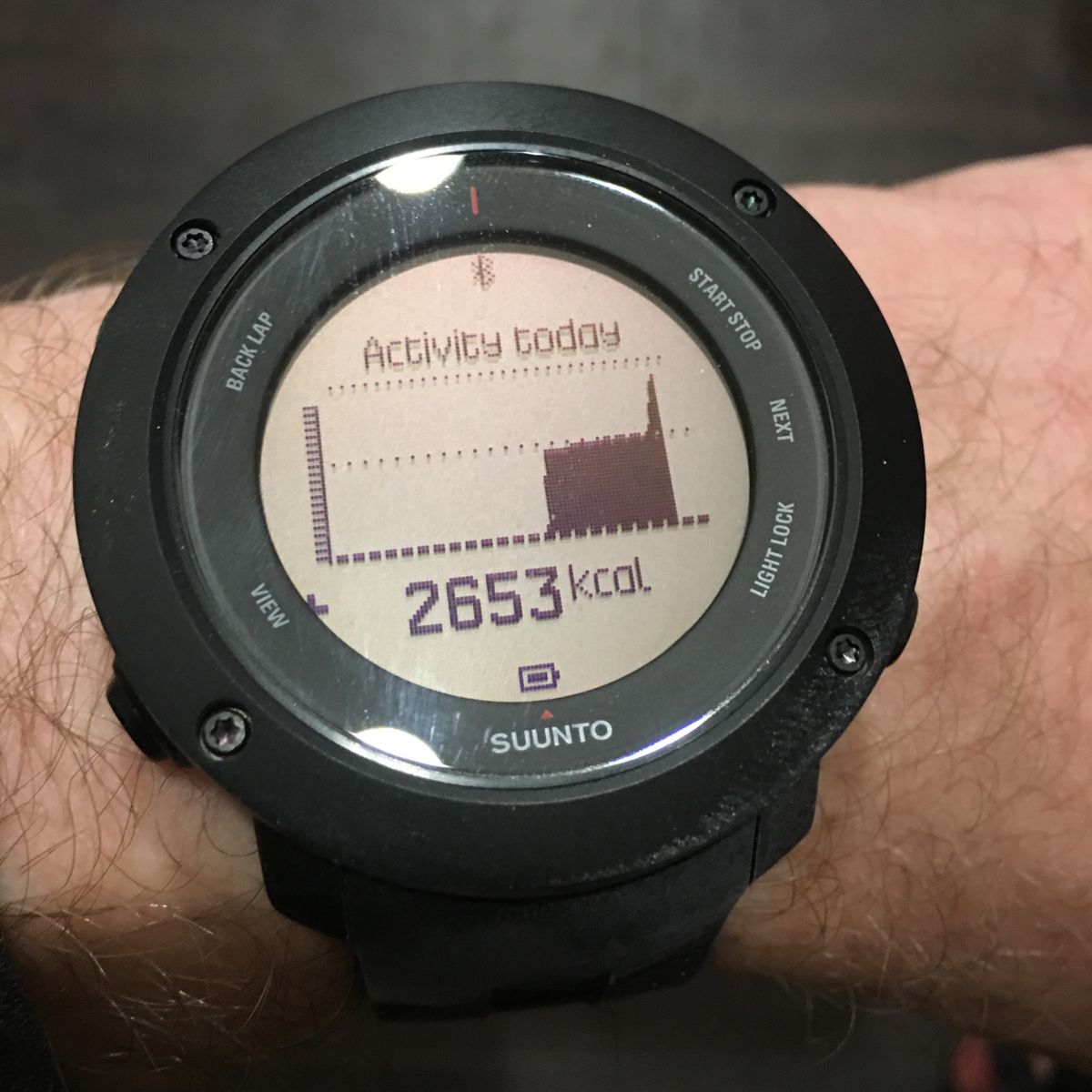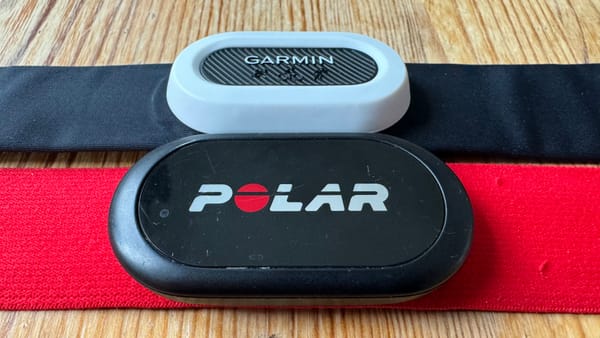A week with the Suunto Ambit3 Vertical, and thoughts on the Ambit line

Update: this is continued here.
Last Wednesday, I received my Suunto Ambit3 Vertical. Having a new hardware design — a recycled Traverse — it presents itself more as an Ambit 3.5 than one of the existing range.
Initial Observations
The first, most apparent difference is the removal of the GPS antenna ‘nub’ that has typified the Ambit watches over the last three iterations, bringing with it compatibility with standard watch straps. Coming from the Peak, I am used to the larger dimensions (18.9mm vs. 15.3mm), making the Vertical feel a lot like the Core on my wrist. The reduction in depth comes with a reduction in weight (74.9g vs. 87.5g), which while not seeming much numerically, is noticeable. The smoother design makes it easier to tuck under a sleeve. What I find most impressive is that the nub has been lost, moving the GPS chip and antenna inside the body of the watch, but the only sacrifice seems to be the battery life.
Those used to a protective bezel rising above their screen slightly will be sad to note that the Vertical features entirely flat glass, that fits flush to the edge of the bezel, making this the first time where I considered the relative merits of a sapphire layer over the LCD instead of glass.
The font Suunto use has changed, offering more rounded corners. The display might have changed too; it appears to have a slightly purple hue to it when compared to a Peak, but this could be the contrast settings.
Regarding the physical interface, nothing has changed: the same USB cable clips on in the same way, and there are five buttons, two on the left and three on the right of the face. The buttons are more lightly sprung than on the Peak, and offer a crisper feedback. When compared to the original Ambit, it’s the difference between pressing a stiff marshmallow and snapping a bubble on a sheet of bubble wrap.
Day-to-day use
The half-size battery is immediately apparent: this, it is important to say, isn’t that battery life is poor. I’ve charged it once since I got it, and after using it to track 149 minutes of activity over six days (cycling, pool swimming, running, climbing, recording data at 1s intervals), it was down to 47%. I have message alerts on from my phone, and includes a higher number of synchronisations a that normal (via Bluetooth) as I move routes, sports settings, workouts et al onto the watch. Realistically, I think the Vertical will need a weekly charge, perhaps 1.5 weeks.
The vibrator in it is sometimes useful, but sometimes just too weak to notice: I notice it most when auto-pause activates at traffic lights, and the watch vibrates four times. When running, with the watch over a very thin fleece, I didn’t feel it vibrate. Longer, more annoying pulses would be welcome, but I’m not sure that they would help.
This could be annecdotal, but when swimming it felt like it was faster at tallying the total length distance swum than the Peak.
Key omissions from the Peak
- Sunrise/sunset times: I can’t imagine why, on a watch targeted at people who tackle ‘vertical’, Suunto decided to remove this key piece of information.
- Access to barometric data: the Vertical is feature-restricted to only show altitude data, but, in order to track altitude accurately, the watch has to assess if a pressure change is from weather, or from movement. In order to focus this watch at a new market, Suunto have stripped off a feature, which I’m sure could be present otherwise.
- Storm Alarm: along with barometric data, there is no general Storm Alarm. While this worked perfectly on my Core, I ended up turning it off on my Peak as it was wrong so often. I don’t miss it, but again, in a watch targeted at people who go up high things it seems like an odd omission.
When looking at these omissions, a cynic would suggest that Suunto is deliberately designing one hardware platform (in use in the Kailash, Traverse and Vertical), and releasing different software sets to try and capitalise market share. Whilst I would very much like Suunto to have more market share, I feel mostly confused by their design choices: there was a clear escalation from the Ambit3 Run to the Sport to the Peak, but now the ‘ultimate’ watch is harder to determine.
Cynicism aside, I do not know how much memory Suunto have to work with in this platform: it could be that they are so limited that in order to make the watch responsive, the code base had to be trimmed. I’d love to know the answer to that.
Alternately, this watch could be aimed at a sort of person — a veritable Gipfelstürmer — who gets to their objective and back so fast that weather and daylight information is irrelevant.
Regarding the omission of the step counter
The Vertical’s cousins, Kailash and Traverse, both feature a step counter, which some people have bemoaned the lack of. I think this is a clear design choice: the Vertical has all the (excellent) sports tracking functions of the Peak, which renders such trivial data as step count meaningless in the face of far greater exercise. Since I started to use my Peak to its full potential (i.e.: exercise a lot more) I’ve removed the step count graph from Apple Health, as the data it gathers isn’t relevant/interesting.
The above paragraph assumes that the step count is derived from analysis of the same accelerometer hardware that provides cadence data for running: it is possible that this isn’t the case, and that there’s a different component on the board, but that seems unlikely given the similarity of function.
Who is the Vertical targeted at?
Cynically, again, I think the Vertical is targeted at owners of the Peak who want a new toy, as well as those who partake in 1km ‘vertical’ sprints. Not to detract from the device as a stand-alone product, but when viewed with the rest of the Ambit/Traverse/Kailash range I think of it as a stop-gap model until the Ambit4 Summit is released, giving an athlete all the data recording and analysis they need, but in a smaller form factor.
A note on the positioning chipset, and accuracy
As stated in the manual for both the Peak and the Vertical, they feature the same chipset. This chipset supports both the American GPS, and Russian GLONASS. While the Vertical doesn’t have GLONASS yet, when Suunto release this feature in firmware, it’ll be very interesting to see if they extend it back to the Peak.
There are some reports saying that the Vertical is less accurate than the Peak. I haven’t used mine enough to determine this, but the Peak is incredibly accurate: when running recently, I had to run around a van that at parked at 45 degrees on the pavement: the GPS track shows this deviation to the left and back to the right, so the Vertical has stiff competition. Given that Suunto have stated (if not directly) the positioning code isn’t complete yet, if there is any inaccuracy now, I imagine it will be removed with this update.
Where do we go from here?
One of the most appealing features of Suunto’s products, compared to say, the Fenix product line, is the lack of features. I love that the watch does not have a colour screen, and that everything (OK except the Storm Alarm) works perfectly. The line has a tight, tested feature set and I hope that when the Ambit4 Summit is released, it continues the trend of eschewing gaudy features for precise function. And has a stronger vibrator.
Ambit4 Summit
This is a title I made up. I have no idea what the high-end Ambit4 will be called, but I’m bored of the word Peak, and Pinnacle didn’t seem to fit. I hope there will be a special-edition of the Ambit4 Summit called Ambit4 Gipfelstürmer.
Update: this is continued here.



